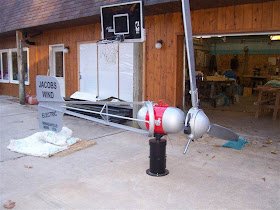Its been one year since we put in our PV system, so I thought I would do a little report on how its performed, and what living with the system has been like.
The system is ten 215 watt panels and uses the Enphase micro-inverters with each panel getting its own grid-tied inverter.
 |
| Our ten panel, 2150 watt micro-inverter PV system. |
In a nutsehll:
- The system has been trouble free -- no repairs or problems.
- The maintenance has been very minimal -- wash the dust off once in a while, brush off the snow, inspect the system for problems.
- Performance has been about 8% above the PVWatts estimate for the year
The system produced 3320 KWH for the year -- about 8% more than PVWatts going in estimate.
 |
| Building the mounts and installing the PV panels. |
Its interesting (maybe) to note that when we moved into the house our power consumption was up at around 1000 KWH per month -- near the US average. We pursed a bunch of conservation and efficiency measures which got our usage down to right around 500 KWH per month. All these changes are spelled out
here in our Half Program. The cost of all the conservation measures was about $1,200 dollars.
We then added the PV system, which generates about 275 KWH per month, and takes our net consumption down toward 200 KWH per month. The PV system cost us about $10,000 ($6,500 after rebates). So, for us, the
conservation measures were about ten times more cost effective in saving electricity than the PV system.
The message is do the conservation stuff first -- after you've gotten your consumption down, then think about a PV system to work on the remaining usage. This approach will save you a ton of money compared to just installing a PV system that is big enough to meet your current usage.
We are still working on conservation, and I think we can get down to less than 100 KWH a month -- maybe even down to a net zero for the year. A 100 KWH per month is a lot of electricity if used carefully -- as any off-grider will tell you.
More details on the first year of use experiences...
(Including how solar thermal DIY systems compare to solar PV DIY systems)
Full "how to" on planning and installing our grid-tie system...
Lots more on building your own PV system...
Gary













